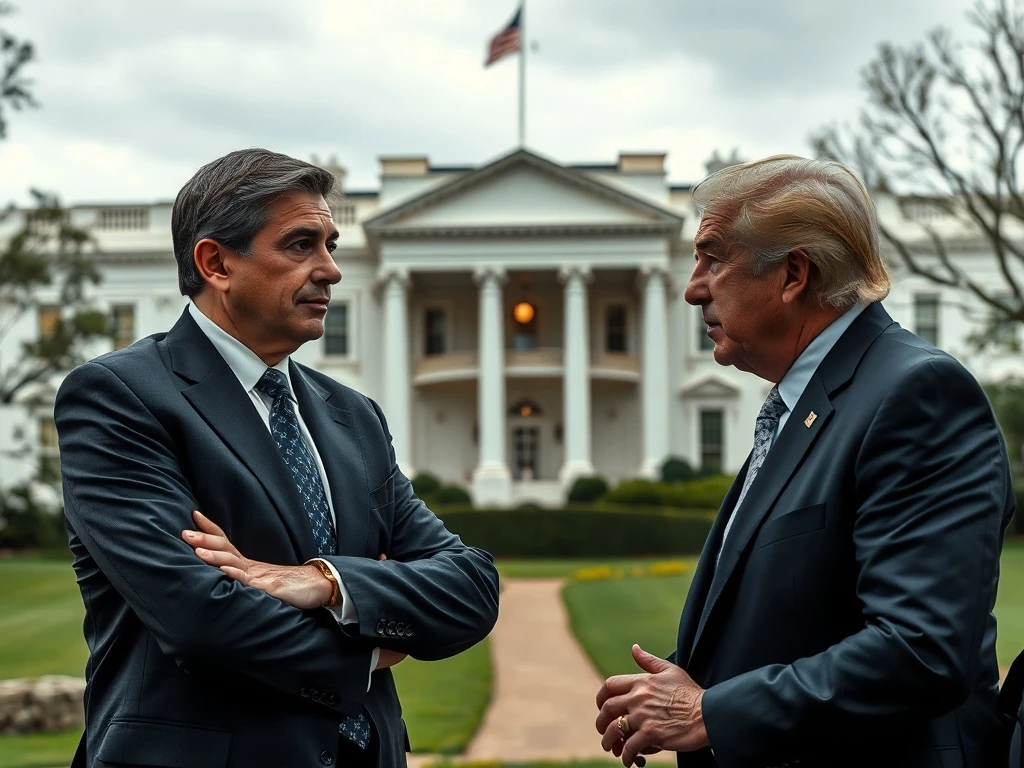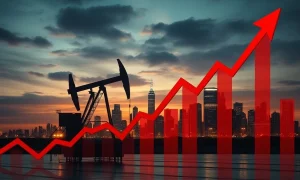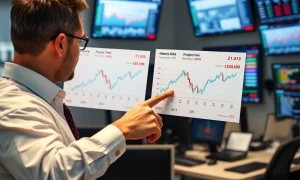The financial world recently witnessed a significant clash. **Goldman Sachs CEO** David Solomon found his firm’s economic forecast directly challenged by the White House. This public dispute highlighted the inherent tensions between major corporate leadership and government economic perspectives. It also underscored how critical financial outlooks can become politically charged. Consequently, market watchers and policy experts paid close attention to the unfolding situation.
The Goldman Sachs CEO’s Cautious Economic Outlook
David Solomon, as the current **Goldman Sachs CEO**, leads one of the most influential investment banks globally. His public statements and the firm’s research carry substantial weight. Recently, Goldman Sachs released a revised economic outlook. This forecast painted a notably cautious picture for the coming year. It suggested a higher probability of an economic downturn. Furthermore, it indicated persistent inflationary pressures. Such assessments often significantly influence investor sentiment and corporate strategy. Therefore, financial markets closely monitor these detailed reports.
The firm’s analysis pointed to several concerning indicators. Firstly, rising interest rates were highlighted as a potential brake on growth. Secondly, geopolitical uncertainties added to the complexity. Finally, ongoing supply chain disruptions continued to impact various sectors. These factors, according to Goldman Sachs, increased the likelihood of a recession. Their outlook provided a stark contrast to more optimistic government narratives. Consequently, the stage was set for a disagreement.
White House Rebuttal: A Clash of Economic Narratives
The White House swiftly responded to the forecast from the **Goldman Sachs CEO** and his team. Administration officials publicly expressed their disagreement. They argued that the Goldman Sachs forecast did not fully capture the American economy’s underlying resilience. Moreover, they highlighted several positive indicators. These included robust job growth, declining unemployment rates, and strong consumer spending data. They maintained that these factors pointed towards continued economic expansion, not contraction.
This strong pushback from the White House reflects a broader strategic objective. The administration aims to maintain public confidence in the economy. They also seek to validate their current economic policies. Dissenting views from prominent financial figures, like the **Goldman Sachs CEO**, can potentially undermine this narrative. Therefore, managing public perception regarding the economic outlook becomes a crucial task for any administration. This particular instance became a high-profile example of such efforts.
The Core Disagreement: Forecast Details and Policy Implications
At the heart of the contention lies the interpretation of complex economic data. **Goldman Sachs CEO** David Solomon and his analytical team focused on specific metrics. They emphasized the cumulative effect of monetary policy tightening. They also noted the lingering effects of global supply chain issues. Furthermore, they considered the impact of energy price volatility. Their model suggested a significant risk of a recession within the next 12 months. This projection directly challenged the White House’s more sanguine assessment.
Conversely, the White House emphasized different data points to support their optimistic view. They pointed to the strong labor market, with historically low unemployment. They also highlighted the decrease in gas prices from their peak. Additionally, they referenced significant infrastructure investments boosting economic activity. Thus, both parties presented valid but ultimately differing perspectives on the economy’s trajectory. This divergence created a public debate, drawing significant media attention.
Key Points of Contention:
- **Recession Probability:** Goldman Sachs suggested a significant chance of an economic downturn; the White House strongly downplayed this possibility.
- **Inflation Outlook:** The bank foresaw continued elevated inflation; the administration predicted a more rapid moderation.
- **Policy Efficacy:** Goldman Sachs assessed current government policies might not avert a slowdown; the White House staunchly defended their effectiveness in stabilizing and growing the economy.
Market Implications and Political Dynamics for the Goldman Sachs CEO
Such public disagreements between influential financial institutions and government bodies can create market volatility. Investors often seek clarity and consensus regarding economic forecasts. Conflicting signals from a major player like Goldman Sachs and the nation’s highest office can cause considerable uncertainty. For example, stock futures might react sharply to these conflicting narratives. Bond yields could also fluctuate, reflecting investor apprehension. Therefore, market participants closely watched this unfolding scenario involving the **Goldman Sachs CEO**.
Politically, the White House’s firm stance is entirely understandable. They strive to control the dominant economic narrative. A negative forecast from a highly respected firm like Goldman Sachs could potentially undermine public trust in the administration’s economic stewardship. It might also impact consumer confidence and spending behavior. Consequently, managing this public perception becomes an extremely critical aspect of their governance. This specific incident became a clear demonstration of that ongoing effort.
Navigating High-Stakes Disagreements: Lessons from the Goldman Sachs CEO Controversy
This recent incident is not unique in financial history. Tensions frequently arise between independent financial institutions and government administrations. Both entities have distinct but interconnected roles. Banks like Goldman Sachs provide independent market analysis and economic projections. Governments, however, are tasked with managing the broader economy and shaping public perception. These differing objectives can naturally lead to disagreements over economic outlooks. Therefore, such clashes are an inherent part of the economic landscape.
The controversy involving the **Goldman Sachs CEO** underscores several important lessons for both public and private sectors. Firstly, transparency in economic forecasting remains paramount. Financial institutions must present their data and methodologies clearly. Secondly, open dialogue, even amidst significant disagreement, can foster better understanding. Ultimately, effective communication between these powerful entities benefits everyone. It helps maintain stability and provides clearer guidance for businesses and individuals alike. This event highlighted the delicate balance required.
Conclusion: The Enduring Tension
The recent exchange between the **Goldman Sachs CEO** and the White House highlights a fundamental, enduring tension. It underscores the differing roles of private financial analysis and public economic governance. While both aim for stability and prosperity, their approaches, interpretations, and public statements can diverge significantly. This event serves as a potent reminder of the complex interplay in the global economy. It also emphasizes the constant challenge of aligning varied perspectives for collective benefit. Such debates will undoubtedly continue as economic conditions evolve.
Frequently Asked Questions (FAQs)
Q1: Who is the current Goldman Sachs CEO?
David Solomon currently serves as the Chairman and Chief Executive Officer of Goldman Sachs. He assumed the role in October 2018, succeeding Lloyd Blankfein.
Q2: Why did the White House criticize Goldman Sachs’ economic forecast?
The White House criticized Goldman Sachs’ forecast because it presented a more pessimistic outlook, including a higher probability of recession and persistent inflation, which contradicted the administration’s more optimistic narrative about the economy’s resilience and positive trajectory.
Q3: What was the main point of Goldman Sachs’ economic forecast that caused contention?
The main point of contention was Goldman Sachs’ projection of a significantly higher probability of an economic recession within the next 12 months, coupled with a cautious outlook on inflation moderation, contrasting with the White House’s more positive assessment of economic growth and stability.
Q4: How do such public disagreements impact financial markets?
Public disagreements between major financial institutions and the government can introduce uncertainty and volatility into financial markets. Investors may become apprehensive due to conflicting signals, potentially leading to fluctuations in stock prices, bond yields, and overall market sentiment.
Q5: Is this type of dispute between financial institutions and the government common?
Yes, such disputes are relatively common. Financial institutions often provide independent economic analyses that may differ from government perspectives, which tend to focus on policy defense and public confidence. These disagreements are a natural part of the dynamic relationship between private finance and public governance.
Q6: What is the significance of the Goldman Sachs CEO’s statements?
Statements from the **Goldman Sachs CEO** carry significant weight due to the firm’s global influence and expertise in financial markets. Their economic forecasts can shape investor expectations, corporate strategies, and even public discourse, making their pronouncements closely watched and often impactful.








